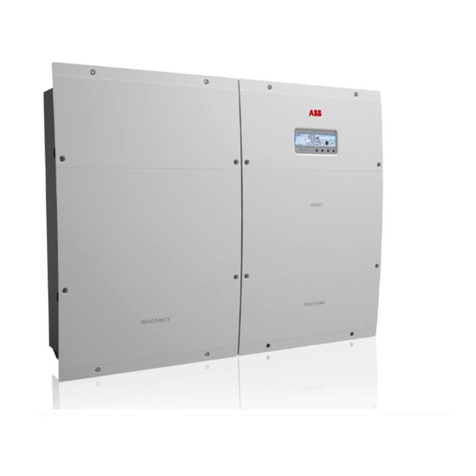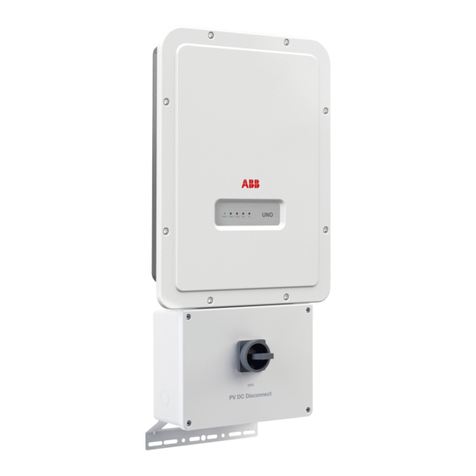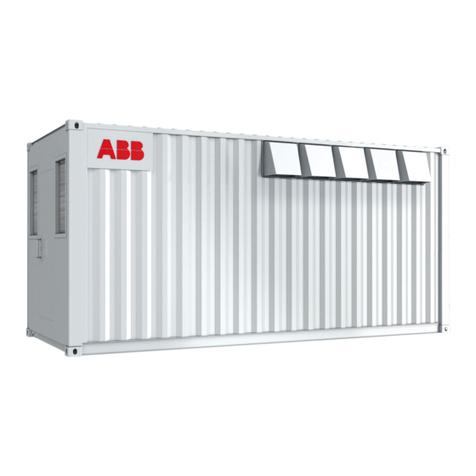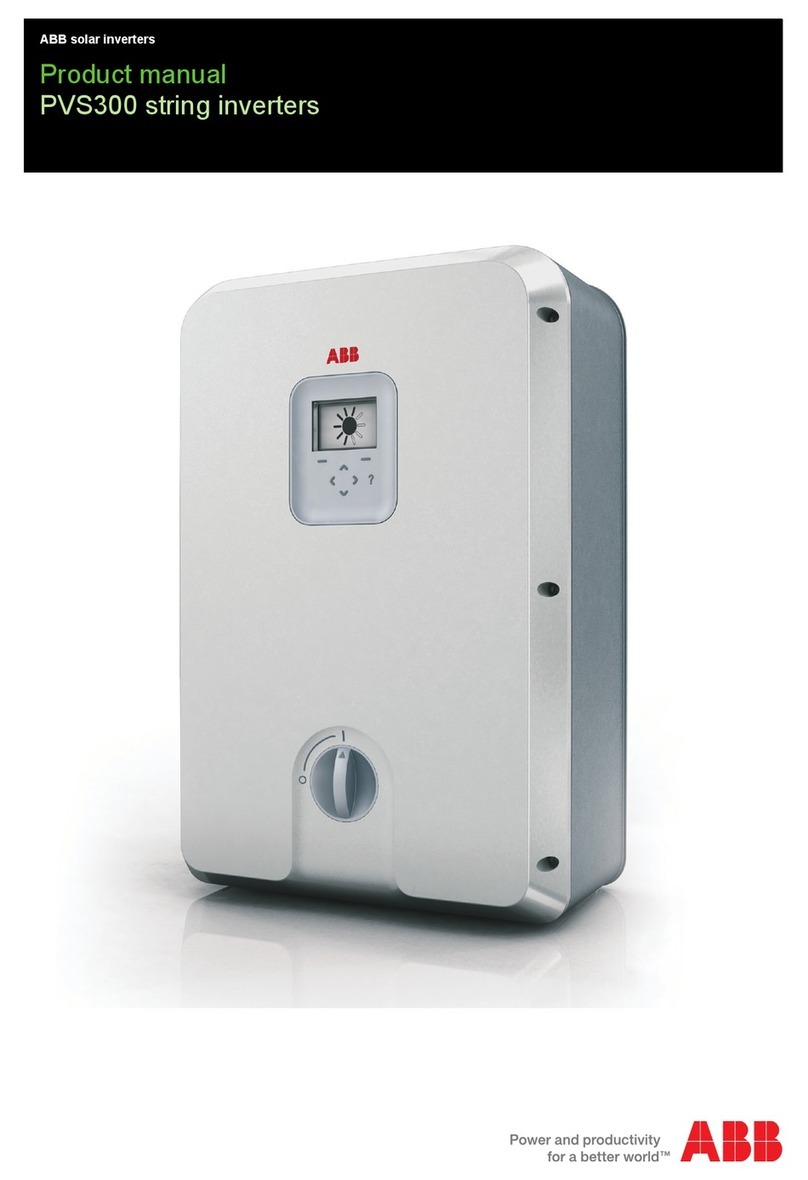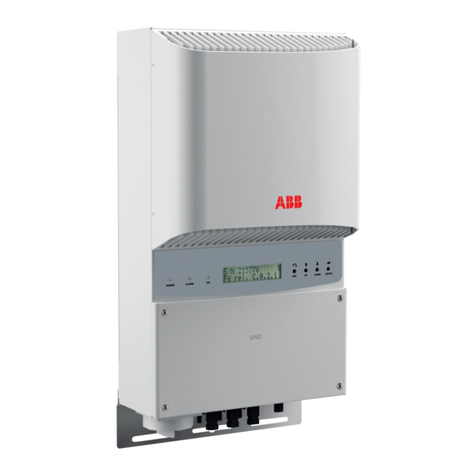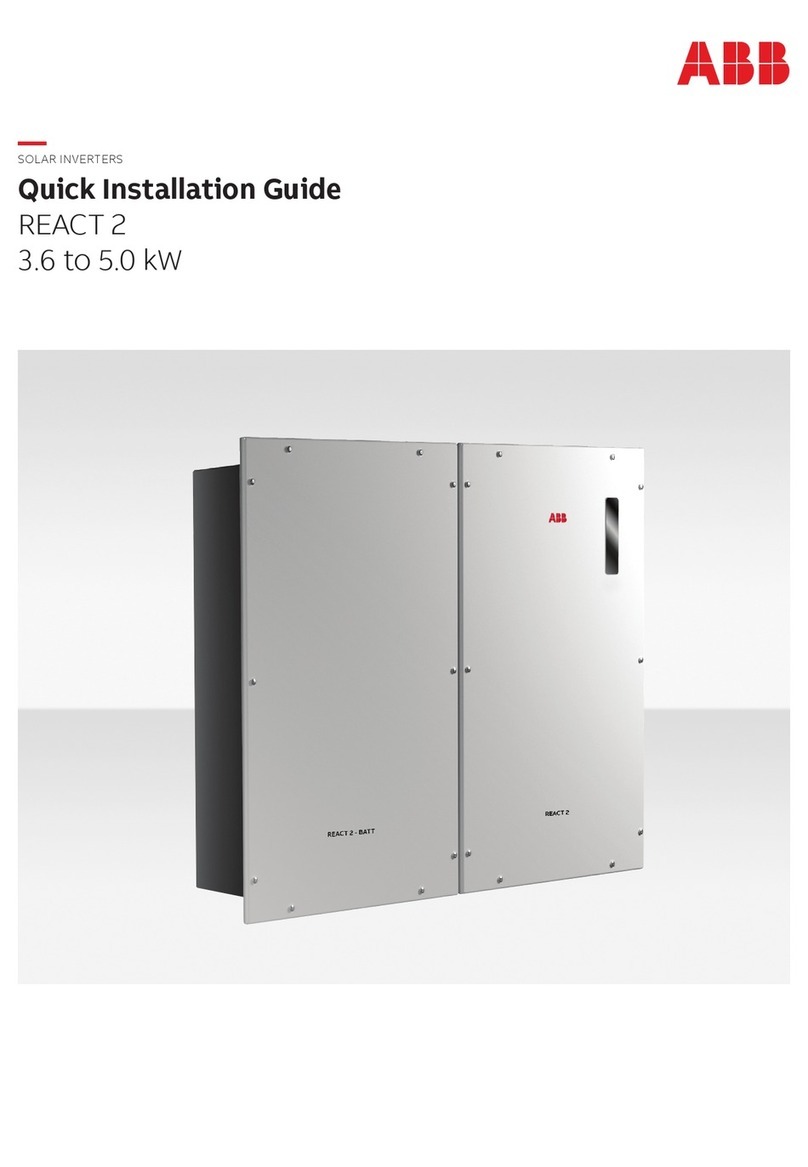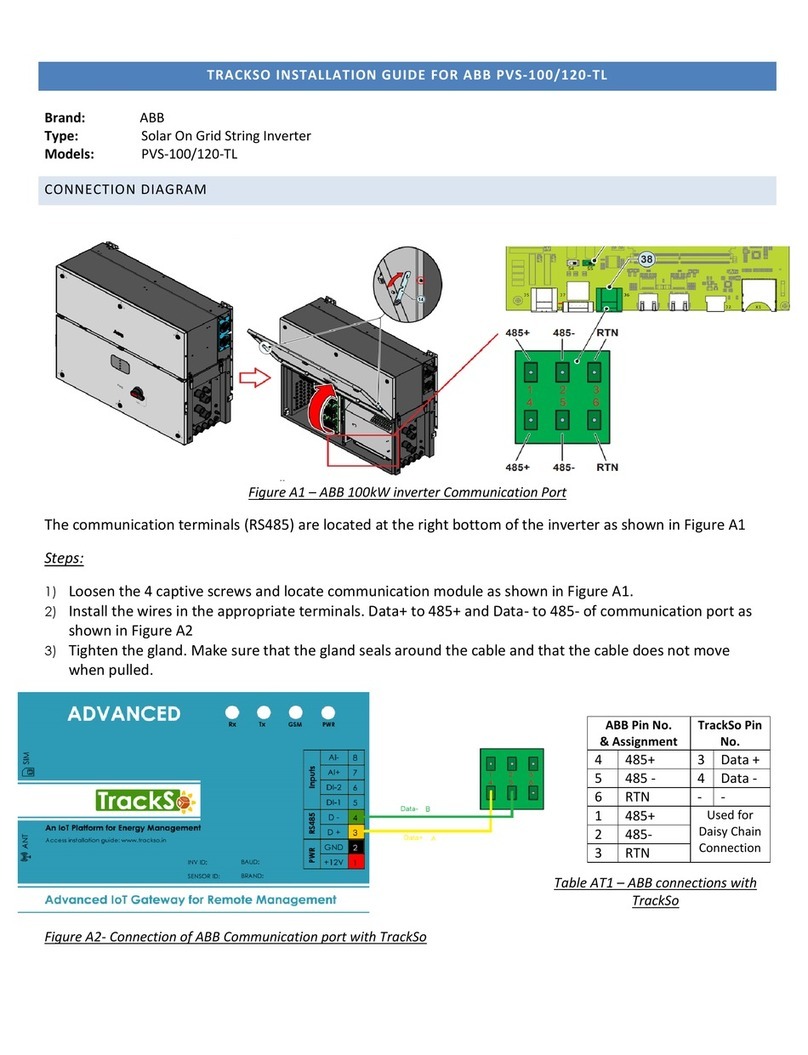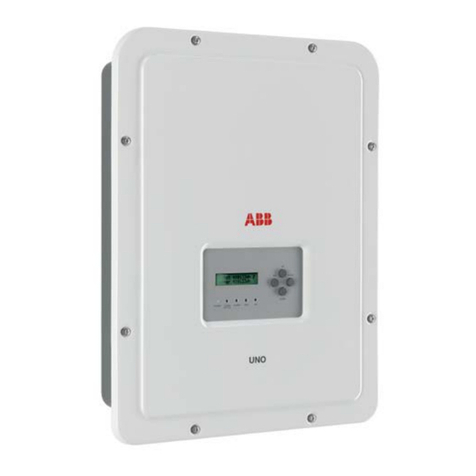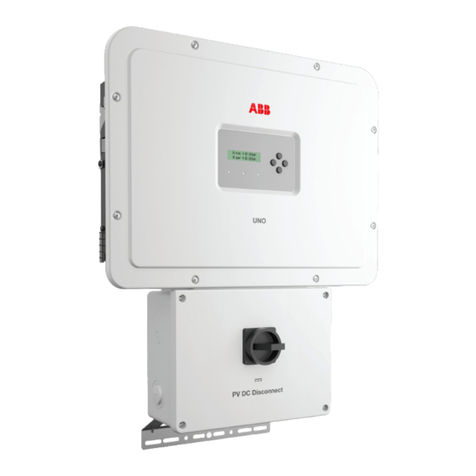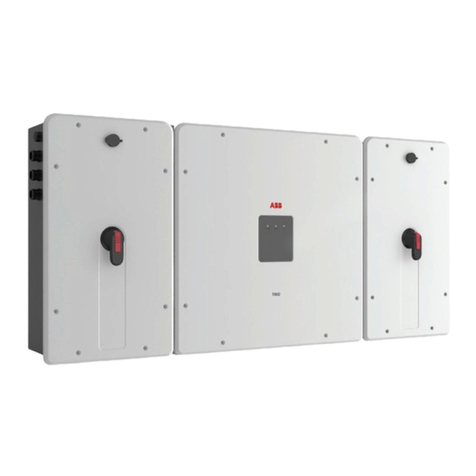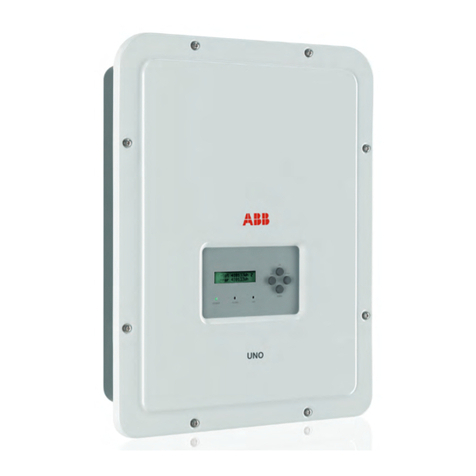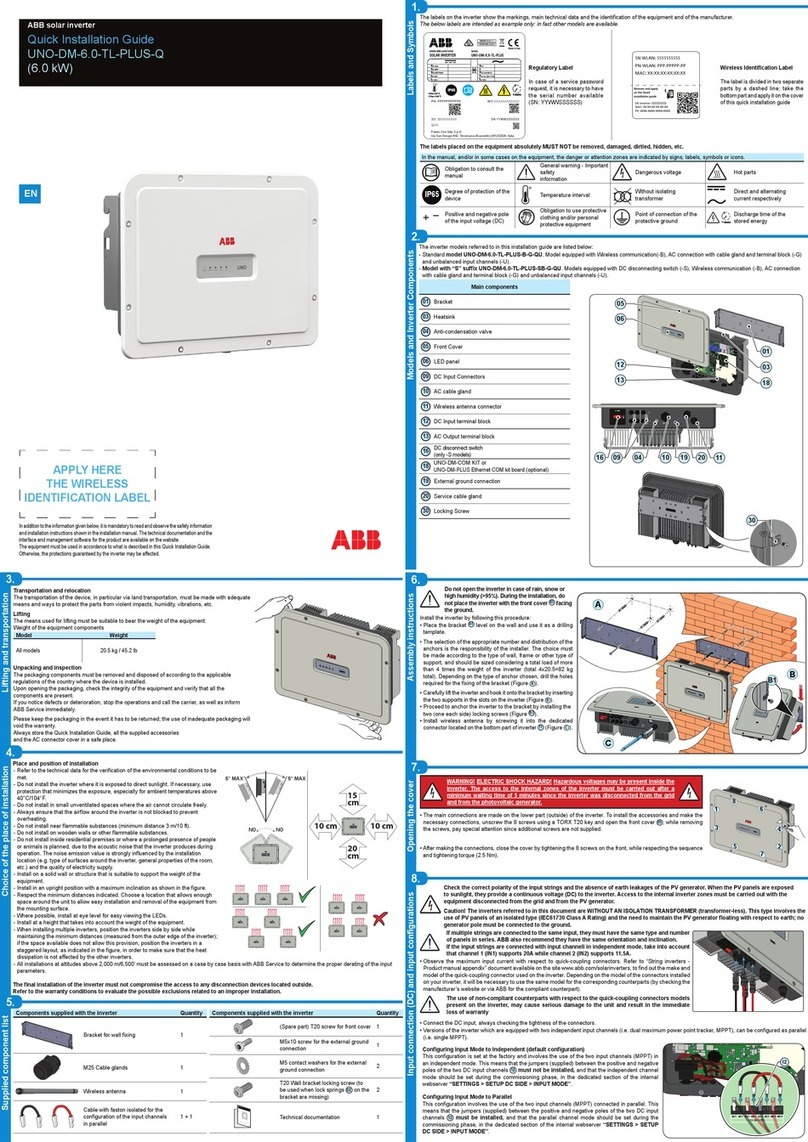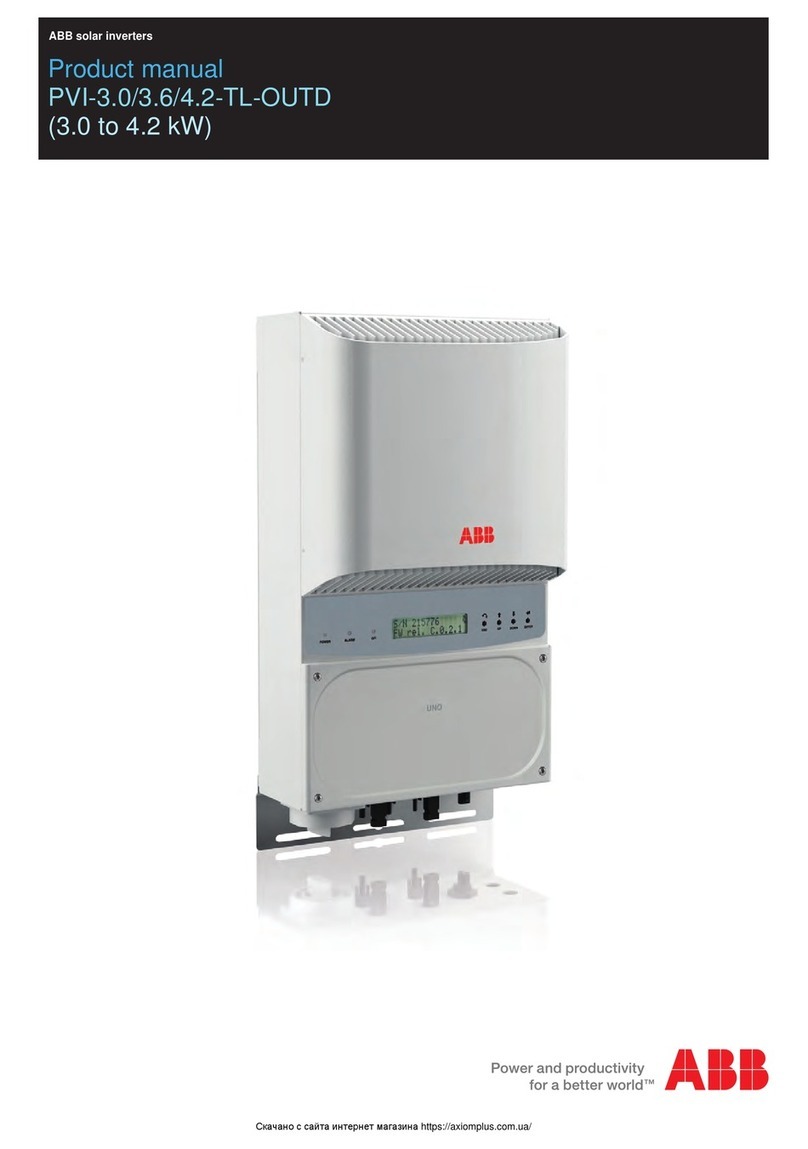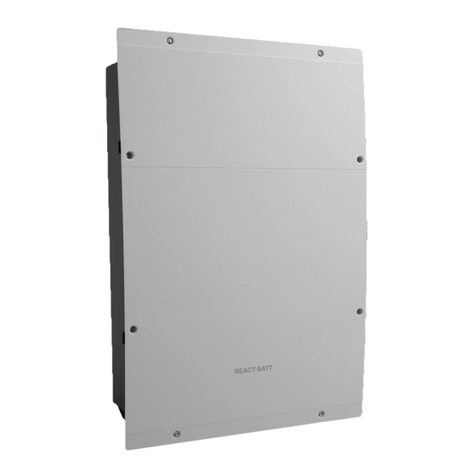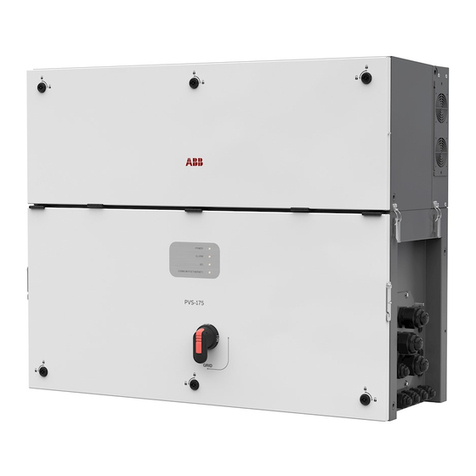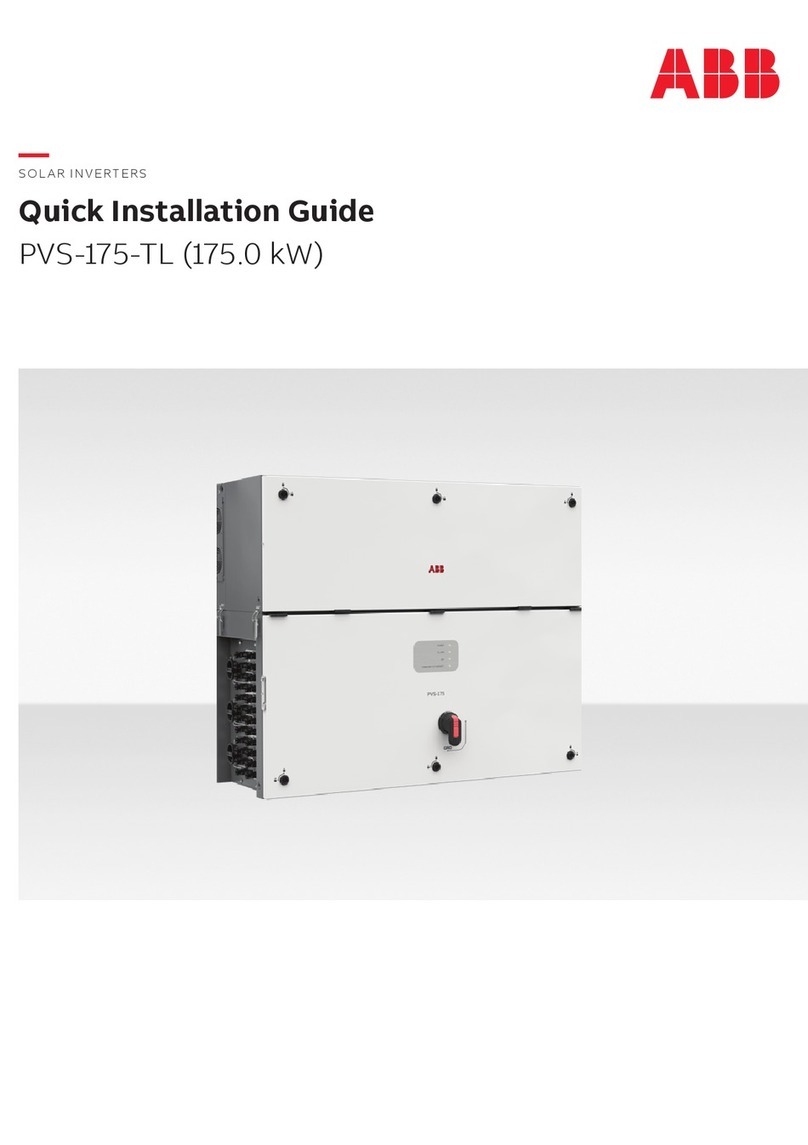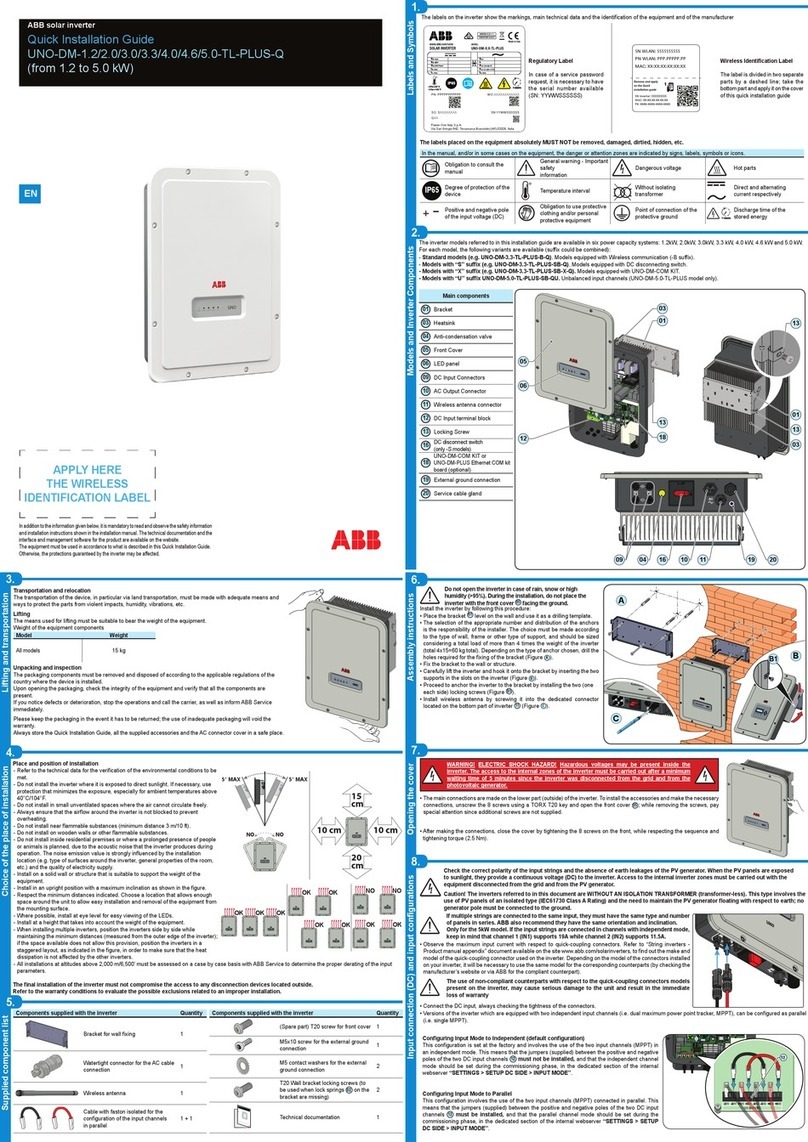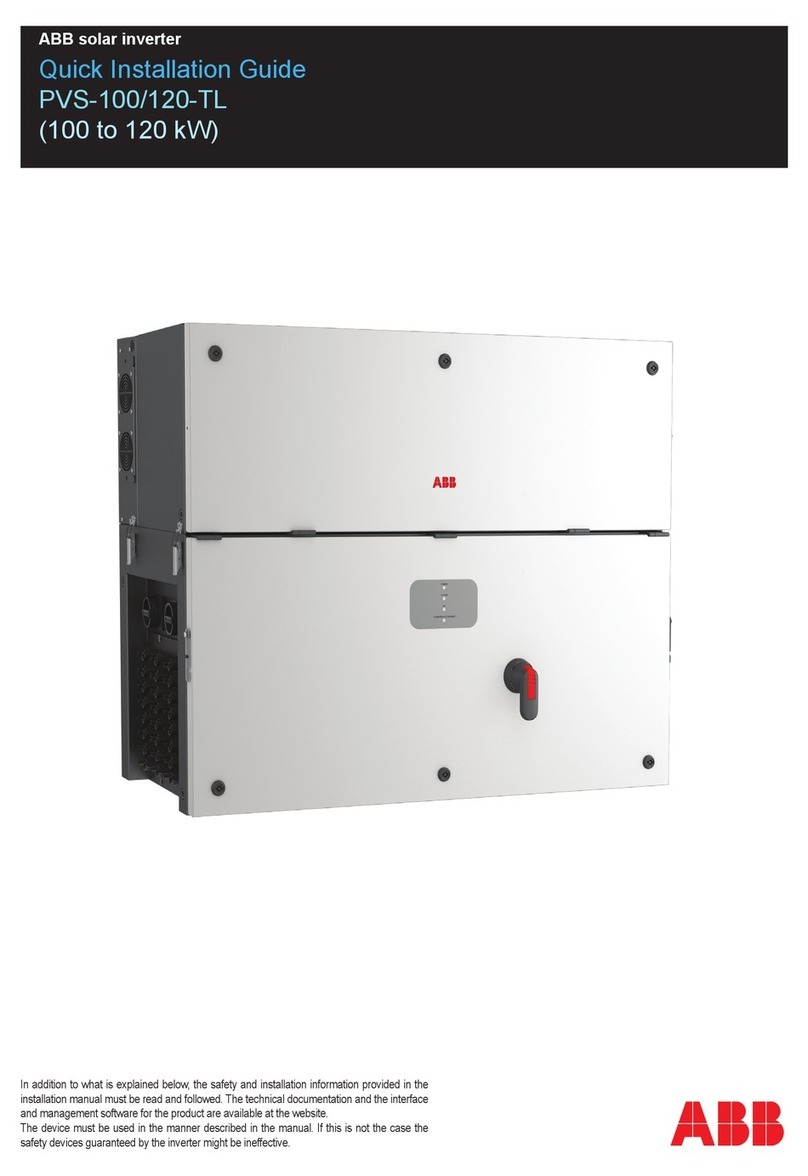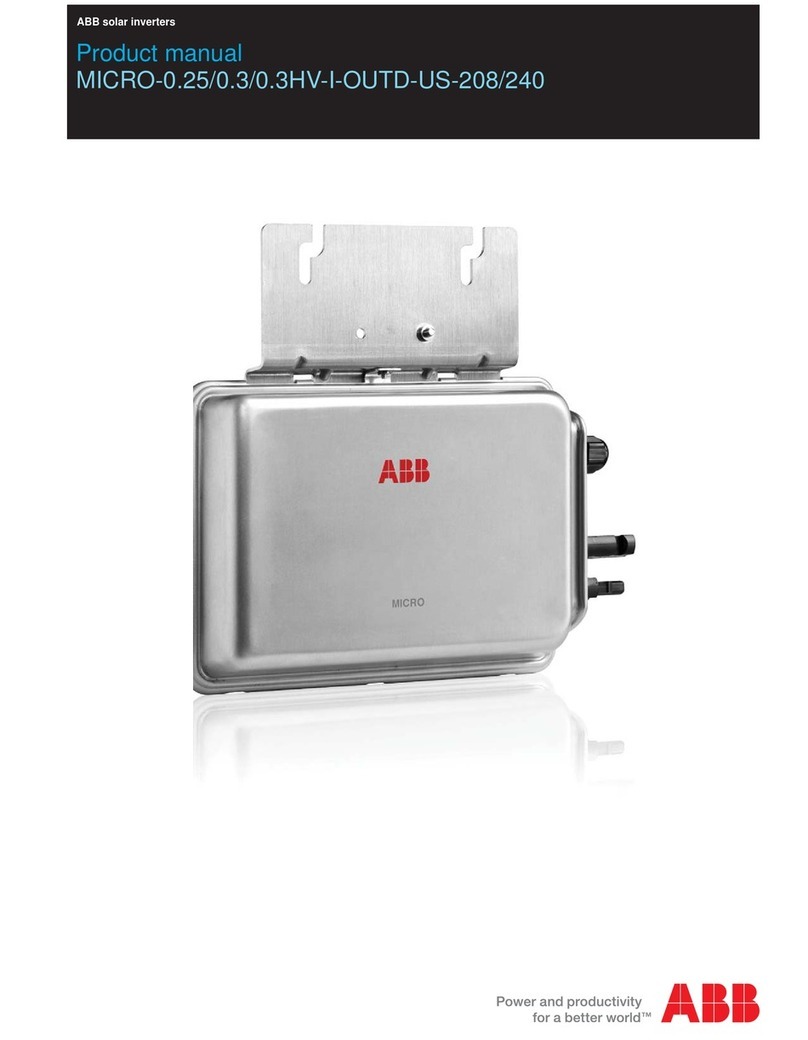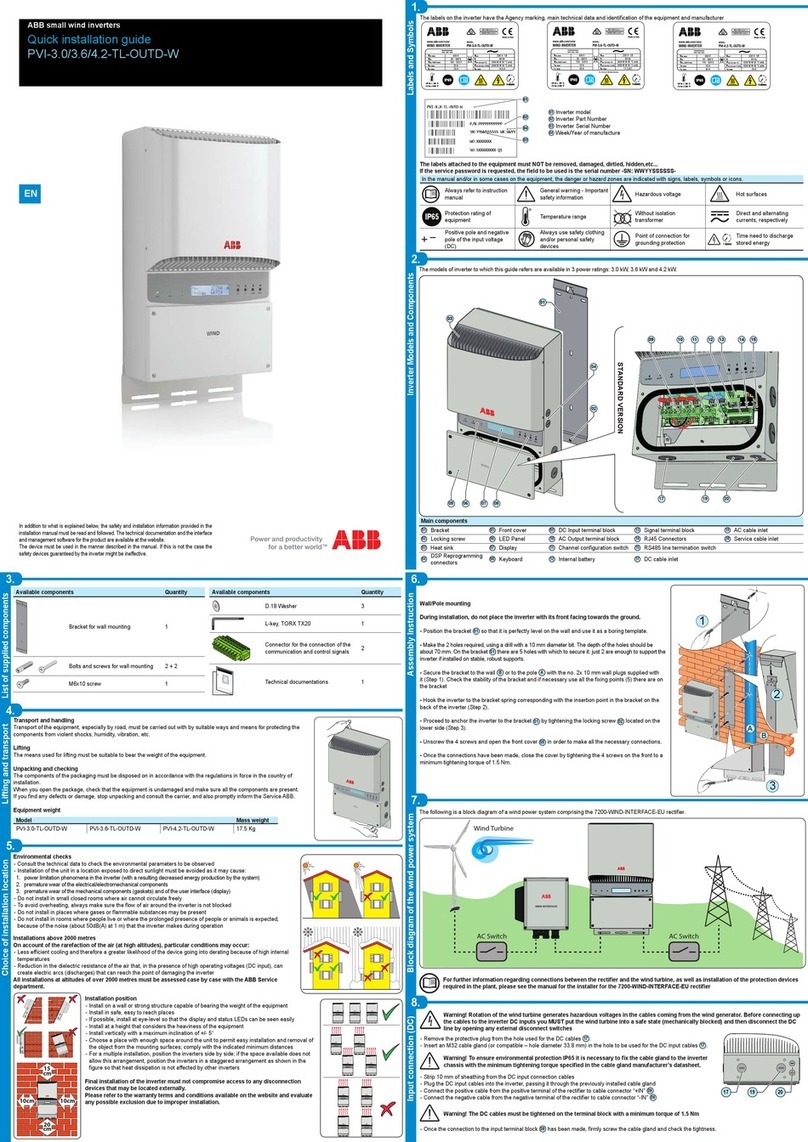10.
AC ouput connections and grid standard
11.
Communication card
17.
Characteristics and technical data
13.
Display and keypad
TRIO-20.0-27.6-TL-OUTD-US (A) Quick installation guide
BCM.00202.1_AA
© Copyright 2014 ABB. All Rights Reserved.
Specications subject to change without notice.
Contact us
www.abb.com/solarinverters
Technical Data Values TRIO-20.0-TL US TRIO-27.6-TL US
Nominal Output Power W20000 27600
Maximum Output Power W22000* 30000*
Rated Grid AC Voltage V480 480
Number of Independent MPPT Channels 2 2
Maximum Usable Power for Each MPPT Channel W12000 16000
Absolute Maximum Voltage (Vmax) V1000 1000
Start- Up Voltage (Vstart) V360 (adj. 250-500) 360 (adj. 250-500)
Full Power MPPT Voltage Range V450-800 520-800
Operating MPPT Voltage Range V200-950 200-950
Maximum Usable Current (Idc max) for both MPPT in Parallel A50.0 61.8
Maximum Usable Current (Idc max) per MPPT Channel A25.0 30.9
Maximum Short Circuit Current (Isc max) per MPPT Channel A30.0 36.0
Max. Short Circuit Current (Isc max) for both MPPT in Parallel A60.0 72.0
Number of Wire Landing Terminals per MPPT Channel -S version: 2, -S1, -S1A, -S1B version: 8
Array Wiring Termination Type
-S version: Terminal Block, Screw Terminal, Copper Only 12AWG-2AWG,
type B or C stranding 19 strand max per conductor
S1, -S1A, -S1B version: Touch-safe fuse holder, Screw Terminal, Copper Only 12AWG-6AWG, type B or
C stranding (19 strand max per conductor)
Grid Connection Type 3Ø/3W or 4W+Ground 3Ø/3W or 4W+Ground
Default Voltage Range V422-528 422-528
Adjustable Voltage Range V240-552 240-552
Nominal Grid Frequency Hz 60 60
Adjustable Grid Frequency Range Hz 57-63 57-63
Maximum Current (Iac max/phase) ARMS 27.0 36.0
Power Factor > 0.995 > 0.995
Total Harmonic Distortion At Rated Power %<3 <3
Grid Wiring Termination Type Spring Tension Clamp Terminal, Copper wiring only, 6AWG-4AWG, type B or C stranding
(19 strand max per conductor)
Fault Current ARMS 35.0 46.0
Reverse Polarity Protection Yes. Passive inverter protection only.**
Supplementary Over-Voltage Protection Type For Each MPPT -S1, -S1A, -S1B versions only: Plug-in Class II Modular Surge Arrester
PV Array Ground Fault Detection Meets UL1741/NEC 690.5 requirements
Anti-Islanding Protection Meets UL1741/IEEE1547 requirements
Supplementary Over-Voltage Protection Type -S1A version: Plug-in Class II Modular Surge Arrester
Maximum Efciency %98.2 98.2
CEC Efciency %97.5 97.5
Feed-In Power Threshold WRMS 65 70
Stand-by Consumption WRMS <8 <8
User-Interface (Display) 5.5” x 1.25” Graphic Display
Standard Communication Interfaces (1) RS485 Connection can be congured for AURORA Protocol or Modbus RTU.
Optional Remote Monitoring Logger AURORA Logger Commercial (optional)
Ambient Operating Temperature Range F(°C) -22 to +140 (-30 to +60) , Derating above +113 (45)
Ambient Storage Temperature Range F(°C) -40 to +185 (-40 to +85)
Relative Humidity %RH 0-100 condensing
Acoustic Noise Emission Level dbA @1m <50 <50
Maximum Operating Altitude without Derating ft(m) 6560 (2000) 6560 (2000)
Enclosure rating NEMA 4X
Conduit Connections Bottom: (2) Concentric EKOs 1”,1½ ” , (2) ½” plugged openings, (1) 1” plugged opening
Optional PV String Combiner Fuse Size/Type A/V mm 15/1000 10x38 15/1000 10x38
DC Switch Current Rating (Per Contact) A36 36
Optional AC Fused Disconnect Current Rating (Per Contact) A35 45
Isolation Level Transformerless. Floating Array Required
Safety and EMC Standard UL 1741, IEEE 1547, IEEE1547.1, CSA C22.2 107.1-01-2001, FCC Part 15 Sub-part B Class B Limits
Safety Approval cCSAus
All data is subject to change without notice.
*Capability enabled within maximum input current, maximum input power, maximum output current, and ambient operating temperature limits.
**In -S1, -S1A and -S1B models, string polarity must be veried before connection. Please refer to installation manual for correct installation procedure.
WHEN CONNECTING THE DC CONDUCTORS VERIFY POLARITY PRIOR TO TERMINATING. CONFIRM MAXIMUM SYSTEM VOLTAGE WILL NEVER EXCEED 1000V
PER NEC REQUIREMENTS. FAILURE TO PERFOM THESE CHECKS MAY CAUSE ARCING AND POTENTIAL FIRE.
For suitable wire size (AWG), refer to NFPA National Electrical Code, Table 310.15(B) . Use only Copper (Cu) wire rated for 75°C or 90°C (167°F or
194°F), solid or with type B or type C stranding (19 strands maximum). For conductors with finer stranding, a suitable UL listed wire ferrule must be used.
-S DC input connections - versions with and without AFD
• Remove threaded plastic plug and nut from DC cable opening 11 and insert conduit connector.
• Tighten to chassis to maintain NEMA 4X compliance.
• Connect raceway to chassis, pulling conductors through raceway and DC cable openings 11.
• Connect to DC terminal block 13.
• Acceptable conductor cross-section ranges from #12 AWG to #2AWG, copper conductors only.
• Tighten with at least 53 in-lbs (6Nm) torque.
• Connect any Equipment Grounding conductors in raceway to EGC busbar 27.
-S1, -S1A, -S1B DC input connections - versions with and without AFD
• Remove threaded plastic plug and nut from DC cable opening 11 and insert conduit connector.
• Tighten to chassis to maintain NEMA 4X compliance.
• Connect raceway to chassis, pulling conductors through raceway and DC cable openings 11.
• Remove two CAUTION labels from input fuses and OPEN all fuse holders before connecting.
• Connect conductors to correct input channel on DC terminal block 22. If using parallel conguration,
either input channel is acceptable.
• Wire ranges from #12 AWG to #6 AWG, copper conductors only.
• Fuse holders have screw terminals and torque depends on wire size. For wire sizes #10AWG and
larger, tighten to 30 in-lbs (3.4 Nm) torque.
• Test each string for polarity and voltage using a voltmeter (rated 2000V min.).
• After conrming correct polarity and voltage on all strings, close all fuse holders.
• Connect any Equipment Grounding conductors in raceway to EGC busbar 27.
-S1, -S1A and -S1B versions of wiring box are provisioned with 30A rated UL Listed/CSA certified fuse
holders, supplied with 15A, 1000V DC rated fuses. To determine correct fuse value , refer to PV panel
documentation, NEC 690.8 and 690.9 or local electrical code.
9.
DC input connections
Connection operations must be carried out with external AC
disconnect switch downstream of inverter open and locked out.
For suitable wire size (AWG), refer to NFPA National Electrical Code, Table
310.15(B) for US. Use only Copper (Cu) wire rated for 75°C or 90°C (167°F or
194°F), solid or with type B or type C stranding (19 strands maximum).
For conductors with finer stranding, a suitable UL listed wire ferrule must be
used. Wire must be sized based on ampacity requirements of NEC or other
applicable prevailing code, but no smaller than #8Cu.
• Remove threaded plastic plug from AC cable knockout 16 and replace with
conduit hub sized to t required wiring and raceway. Pull circuit conductors
through conduit opening 16 and connect necessary conductors.
• For a four wire WYE grid, connect Neutral, L1, L2, L3, and EGC conductors.
• For a Delta grid or three wire connection to a four wire grid, connect L1, L2, L3,
and EGC conductors to corresponding terminals on AC Terminal Block 17.
• For either connection type, ground wire connection is mandatory.
When using a three wire connection, unused N terminal must be re-purposed as an
AC ground reference. On AC Terminal Block 17 connect a short jumper of #10AWG
ground wire (green or green/yellow) between N and G terminal.
Remove N marking from Neutral terminal by removing plastic label on chassis.
Grid standard must be set before connecting inverter to grid. Before turning rotary switches, make sure inverter is switched off.
Settings become permanent after 24 hours of operation; inverter does not need to be connected to grid, but only needs DC power to count 24 hours of opertion.
See section 11 below for location of switch a02 on communication card 09 in order to change default setting.
• Use a small at head screwdriver to move dial and line up positions.
• Default setting for North American market is position (0/4).
• To reduce maximum output power move dials to position (1/A).
Grid Settings 20.0kW 27.6kW
(0/4) Default Maximum Output Power 22000 30000
(1/A) Maximum Output Power 20000 27600
A removeable transparent cover prevents access to the communication card in the wiring box; remove four screws in place and remove cover
to connect wiring.
*Refer to technical manual for connections to a03, a04, a05, a06 and Remote a07.
a01 Input mode switch for selecting parallel or independent input
(default = INDEPENDENT , right most position)
a02 Rotary switches for setting country and language of display
a03 Switch for setting analog sensor 1 to Volts or mA *
a04 Switch for setting analog sensor 2 to Volts or mA *
a05 Connection to multi-function relay*
a06 Connection of environmental sensors: AN1,AN2,PT100,
PT1000, and auxiliary 24V service output *
a07 Connection for RS-485 PC line (SERVICE), RS-485 PMU line
(MODBUS), auxiliary 5V output, and remote ON/OFF*
a08 Termination resistance switch for RS-485 PMU line (MODBUS)
a09 Termination resistance switch for RS-485 PC line (SERVICE)
a10 RS-485 PC communication card housing (SERVICE)
a11 RS-485 PMU communication card housing (MODBUS)
a12 NA; for factory use only (default = left most position)
a13 Inverter data memory card housing
a14 CR2032 battery housing
Two RS-485 communication lines are available:
1) SERVICE/PC - dedicated line using AURORA Protocol,
2) MODBUS/PMU - dedicated line for MODBUS RTU
• Remove threaded plastic plugs from service cable opening 10 and replace with conduit connector.
• RS-485 cables must be connected to terminal block a07 on communication card 09.
• Connect either communication port using terminal block a07 (PC+T/R, PC-T/R and GND).
• Use cable designed for use with RS-485 communications (ie Belden 3106A), which is a data cable wire with
one twisted pair, one ground
conductor, and a shield with drain
wire (or equivalent).
• On the last inverter in a daisy
chain, or on single inverter,
activate termination resistance of communication line by moving switch a08 or a09
to ON position.
• Address on inverter is set through user interface on display panel area b7 (section
13). Default address is set at 2.
No more than 63 inverters can be connected to a single RS-485
link, NOT to exceed a length of 3,300 ft/1000m for RS-485 line.
POWERALARM GFI ESC UP DOWN ENTER
POWERALARM GFI ESC UP DOWN ENTER
POWERALARM GFI ESC UP DOWN ENTER
TRIO
TRIO
TRIO
S4
PMU PC
S2
OFF ON
OFF ON
a08
a09
TERM.
120
PMU -T/R
PMU +T/R
GND COM
+5V OUT
R ON/OFF
a07
SH
PC +T/R
PC -T/R
12.
Serial communications
• Operating parameters are displayed on LCD 23.
• LEDs 24 indicate operating state of inverter.
• Keypad 25 is used to review data on cyclical display b7.
• GREEN POWER LED - On if inverter is working correctly. Flashes when
checking grid or if there is insufcient sunlight.
• YELLOW ALARM LED - Inverter has detected an anomaly. Anomaly is
shown in area b7.
• RED GFI LED - Ground fault on DC side of PV array. Error is shown
in area b7.
• ESC - Used to access main menu, go to previous menu or go to
previous digit to be edited.
• UP - Used to scroll up menu options or move numerical scale in
ascending order.
• DOWN - Used to scroll down menu options or move numerical scale in
descending order.
• ENTER - Used to conrm an action, access submenu for selected
option (indicated by > arrow symbol) or move to next digit to be edited.
POWER ALARM GFI ESC UP DOWN ENTER
DC
AC
24 25
b7
23
Description of symbols and display elds on LCD 23
b1 RS485 data transmission b8 Power graph b15 DC/AC circuit part
b2 RS485 line present b9 Total energy b16 AC voltage
b3 Warning b10 Daily energy produced b17 AC current
b4 Temperature derating b11 PV voltage > Vstart b18 Connection to grid
b5 Instantaneous power b12 DC voltage b19 Grid status
b6 MPP scan running b13 DC current b20 Cyclic view on/off
b7 Graphic display b14 DC/DC circuit part
14.
Congure display settings
The inverter commissioning procedure is as follows:
1. Turn the DC disconnect switch in the ON position. If there are two separate external disconnect switches (one for DC and the other for AC), rst close the AC
disconnect switch and then the DC disconnect switch.
2. Once powered, icon b11 comes on to indicate that the voltage from the PV array has reached the Vstart threshold.
For input voltages lower than Vstart, icon b11 remains off, “Waiting Sun” is shown in display area b7 and voltage
and current are present (icons b12 and b13).
3. As soon as “Waiting Sun” conditions are met, the inverter shows the AFD board self-test running. The results are shown in display area b7.
If a problem on the AFD board is detected, the self-test will result in an error. Refer to section 16 below.
4. If there are no irregularities, the grid connection sequence starts. Once all the checks are completed, icon b19 comes on.
During these checks, icon b19 is ashing.
5. Icon b14 ashes to indicate the start-up phase; at the same time icon b15 will come on.
6. Immediately following the grid connection will start. Icon b18 will be displayed in steps until the connection
is complete. After the inverter is connected, the icon b18 will stay “plugged in”.
If there is not sufcient sunlight to connect to the grid, the unit will repeat the procedure until all the parameters controlling connection to the grid (grid
voltage and frequency, conrmation of no ground fault) are within range. During this procedure, the green LED ashes ON and OFF.
15.
Commissioning
For –A models only, the AFD performs a self-test when the system is started. The inverter display shows the results of the self-test in area b7.
• If the self-test results are OK, the inverter will continue to AC grid connection.
• If a potential problem on the AFD board is detected, the self-test will result in error E053.
Refer to the technical manual online for possible solutions to clear the error.
During normal operation the input current is continually measured and analyzed.
• If a DC arc fault is detected during operation, the inverter is disconnected from AC grid and error E050 will be shown on display.
• Press and hold the ESC key for three seconds to clear the E050 error which will start the self-test.
• If self-test results are OK, the inverter will reconnect to the AC grid; if the DC arc fault is still present, the self-test will result in error
E053. Refer to the technical manual online for solutions.
The AFD self-test can be manually started anytime using the following procedure:
1. Turn off the inverter (switching off both DC and AC switches),
2. Turn on both the DC and AC switches and wait for display communication of the self-test result.
